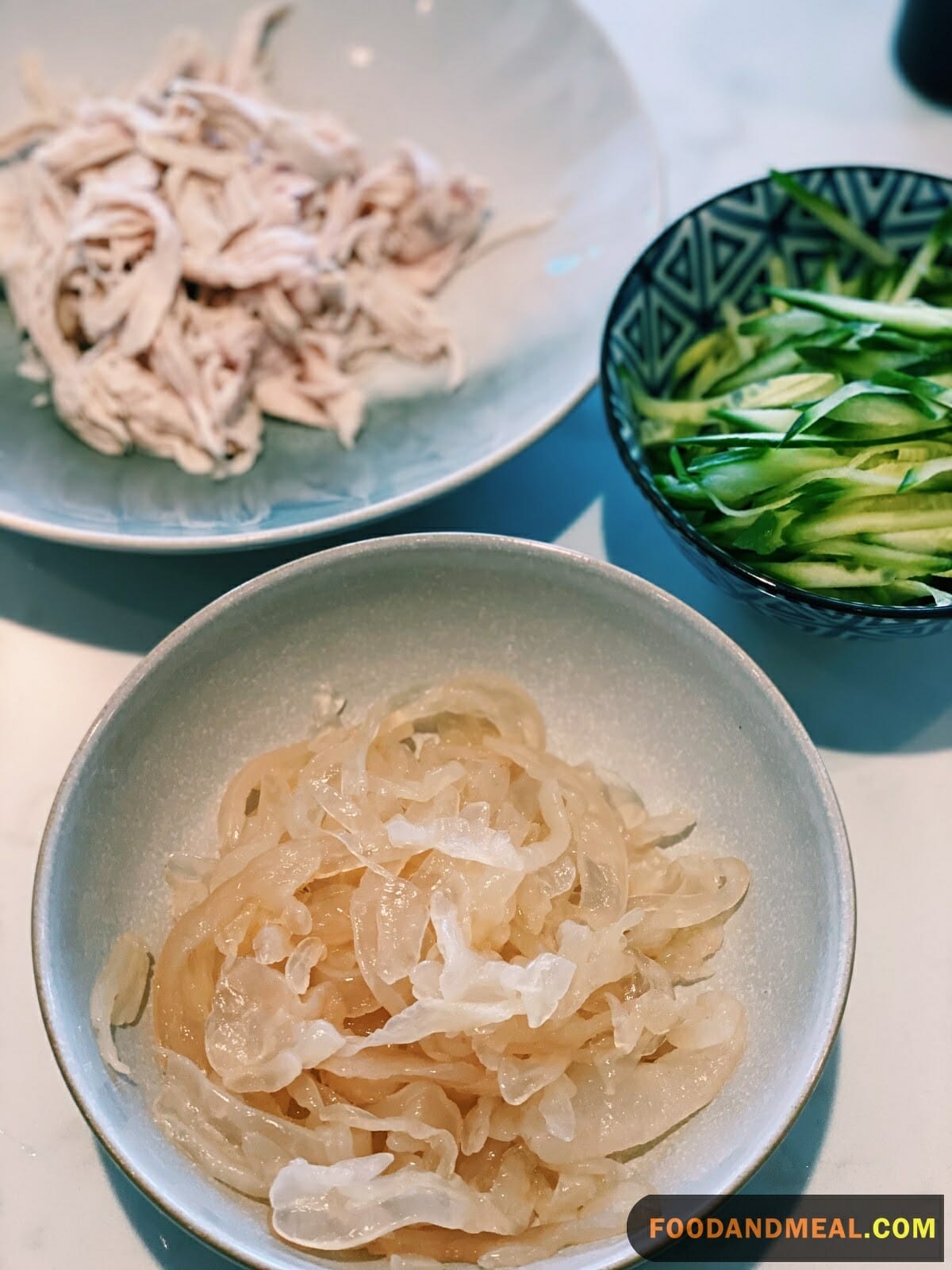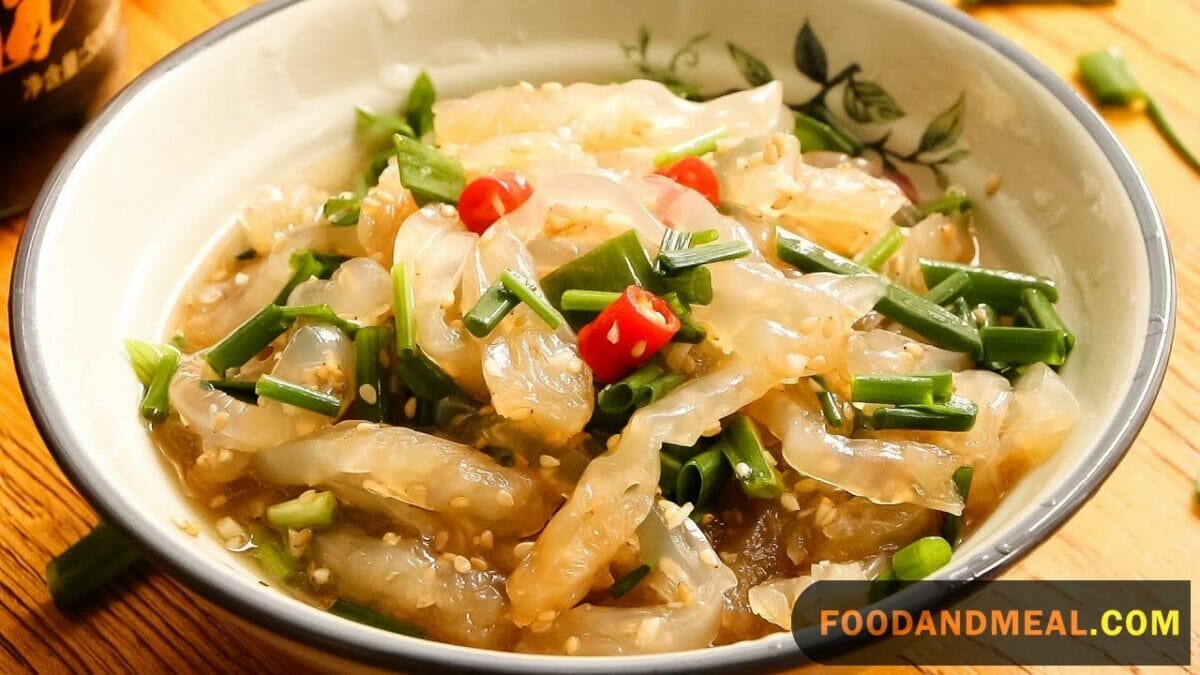As a recipe developer at Food and Meal, I’m always seeking inspiration from cuisines around the world. Lately I’ve become enamored with the bright, balanced flavors of Korean food. During a recent trip to my local Korean market, I discovered preserved jellyfish and was intrigued. Jellyfish salad is a popular Korean banchan, or side dish, though I had never tried it before. As I researched recipes, I learned that the jellyfish itself has little flavor, but soaks up the sweet and savory notes of the dressing beautifully with its crunchy bite.
I felt eager to put my own spin on this unique salad. Carefully slicing and desalting the jellyfish calmed my nerves, transporting me back to childhood days in the kitchen with my halmeoni (grandmother). As I whisked together the dressing ingredients – rice vinegar, soy sauce, sesame oil, garlic and ginger – my anxiety washed away. The aroma was instantly comforting and familiar. Toasted sesame seeds and sweet pickled daikon radish added delightful texture and flavor contrast. As I chilled the salad, I couldn’t resist sneaking little bites of the addictive, chewy jellyfish.
With my first full portion, I was brought back to halmeoni’s table, savoring her banchan with childlike wonder. Each crunchy, salty-sweet morsel sparked nostalgia. Though far from my roots in Malaysia, this Korean jellyfish salad filled me with the warmth of home. I hope it will transport you as well – whether to Seoul, or your own grandmother’s kitchen. As you try this recipe, I’d love to hear your thoughts and memories. Please share in the comments below!

Jellyfish Salad Korean Recipe

JELLYFISH SALAD
Equipment
Ingredients
- 4 ounces salted jellyfish, shredded
- 4 ounces imitation crabmeat, torn into pieces
- 6 ounces kirby or Japanese cucumber, seeded and julienned
- 1/2 carrot, julienned
- 1 tablespoon lemon juice
- 3 tablespoons rice vinegar
- 3 tablespoons sugar
- 1 tablespoon spicy Korean mustard
- 1 teaspoon salt
- 1 tablespoon minced garlic
- 1 tablespoon toasted sesame seeds
Instructions
- Soak the jellyfish in cold water for about 30 minutes to remove the salt. Remove from the water and spread it out in a colander to drain.
- Prepare an ice water bath (a large bowl containing cold water and ice cubes). Pour very hot water over the jellyfish in the colander, and then immediately dunk the jellyfish in the ice water bath.
- Drain the jellyfish again in the colander and pat dry with paper towels.
- In a large bowl, put the jellyfish, imitation crabmeat, cucumber, and carrot. Season with the lemon juice, rice vinegar, sugar, mustard, salt, garlic, and sesame seeds, and toss to combine.
- Serve immediately, or after it’s been chilled for 2 hours.
Video
Notes
- Note on Textures: The key to mastering this dish lies in the play of textures. Ensure your jellyfish retains its crunch while perfectly absorbing the zesty marinade. Enjoyed this insight? Don't forget to share the recipe with fellow food enthusiasts!
- Choosing the Right Jellyfish: Always opt for jellyfish that's clear and free from any blemishes. Remember, the fresher, the better. If this recipe tickled your tastebuds, share the love and joy by passing it on!
- Dressing Matters: For that authentic Korean punch, don't skimp on the sesame oil and Korean pear. Their harmony is what sets this salad apart. Relished the flavors? Subscribe to our blog for more such delightful recipes!
Nutrition
© Food And Meal
This website provides approximate nutrition information for convenience and as a courtesy only. Nutrition data is gathered primarily from the Spoonacular Database, whenever available, or otherwise other online calculators.
Alternative Method: Using a Steamer
To prepare the jellyfish, start by thoroughly rinsing the pre-soaked jellyfish under cold water to remove any remaining impurities. After cleaning, slice the jellyfish into thin, uniform strips, promoting even cooking and enhanced flavor absorption. Arrange the strips in a steamer basket, ensuring proper spacing for efficient steam circulation. In a steamer base or pot, bring water to a rolling boil, making sure it doesn’t touch the base of the steamer basket. Steam the jellyfish for approximately 10-15 minutes until it achieves a slightly translucent and tender texture. After steaming, promptly transfer the jellyfish strips to ice-cold water to maintain their crunchiness through a “shocking” method. Once cooled, drain the jellyfish and mix it with the specified seasoning ingredients. Toss well to ensure every strip is thoroughly coated, ready to be served as desired.
Cooking Tips

First and most critical – properly desalting and slicing the preserved jellyfish. I learned the hard way that insufficient soaking leaves the jellyfish overly salty and tough. My impatience resulted in disappointment at the first bite. But allowing the jellyfish to soak overnight in multiple changes of fresh water yields tender, mild slices that sing with the dressing.
Resist the urge to rush slicing the jellyfish too. Thin, even cuts ensure the jellyfish absorbs flavors and offers delightful chewiness rather than toughness. Approach the task meditatively, finding calm in the repetitive motions. I thought of my Korean halmeoni focused intently on preparing banchan, losing myself in nostalgia for her table.
Finally, balance is key when composing the dressing ingredients. Too much soy sauce or vinegar overwhelms the jellyfish’s subtle flavor. But careful blending allows its texture to shine while carrying well-matched sweet and salty notes. Toasted sesame oil and seeds lend warmth and nuttiness to finish the salad beautifully.
Serving Suggestions

First and most critical – properly desalting and slicing the preserved jellyfish. I learned the hard way that insufficient soaking leaves the jellyfish overly salty and tough. My impatience resulted in disappointment at the first bite. But allowing the jellyfish to soak overnight in multiple changes of fresh water yields tender, mild slices that sing with the dressing.
Resist the urge to rush slicing the jellyfish too. Thin, even cuts ensure the jellyfish absorbs flavors and offers delightful chewiness rather than toughness. Approach the task meditatively, finding calm in the repetitive motions. I thought of my Korean halmeoni focused intently on preparing banchan, losing myself in nostalgia for her table.
Finally, balance is key when composing the dressing ingredients. Too much soy sauce or vinegar overwhelms the jellyfish’s subtle flavor. But careful blending allows its texture to shine while carrying well-matched sweet and salty notes. Toasted sesame oil and seeds lend warmth and nuttiness to finish the salad beautifully.
FAQs of Jellyfish Salad

- What is jellyfish salad made of? Jellyfish salad typically consists of thinly sliced jellyfish that has been cleaned, soaked, and steamed. It is then seasoned with various ingredients like sesame oil, soy sauce, and other flavor-enhancing elements.
- How do you make edible jellyfish? To make edible jellyfish, start by thoroughly cleaning and soaking pre-soaked jellyfish. Slice it into thin, uniform strips and steam for 10-15 minutes until slightly translucent and tender. After steaming, shock the jellyfish by placing it in ice-cold water to maintain its crunchiness. Season according to your preference.
- Is Chinese jellyfish cooked? Yes, Chinese jellyfish is often cooked, commonly in the form of salads. The jellyfish is cleaned, sliced, and then either steamed or boiled before being seasoned and served.
- What kind of jellyfish is edible? Traditionally, cannonball and nomura’s jellyfish are preferred for their firm texture and are commonly used in culinary preparations. However, other types can be experimented with, adjusting the preparation method accordingly.
- Can I use any type of jellyfish for this recipe? Traditionally, cannonball and nomura’s jellyfish are preferred due to their firm texture. However, you can experiment with other types, adjusting the preparation method accordingly.
- I don’t have a steamer; can I boil the jellyfish instead? Absolutely! Boiling is the traditional method. Just ensure you don’t overcook, as the jellyfish can become too soft.
- How long can I store the Jellyfish Salad? In an airtight container, the salad can be refrigerated for up to 3 days. But remember, fresh is best!
- Is there a vegan alternative to jellyfish? While there’s no direct vegan substitute, some chefs use thinly sliced konjac jelly to mimic the texture of jellyfish in vegan versions of the dish.
- The jellyfish turned out too chewy. What went wrong? Overcooking or not adequately preparing (soaking & rinsing) the jellyfish can cause it to turn chewy. Always follow the recommended timings and preparation steps.
Conclusion
As I reflect on my journey preparing this nostalgic Korean jellyfish salad, my heart swells with gratitude. This unique banchan has connected me to fond memories of my childhood and heritage, even while living far from my roots in Malaysia. The chewy, crunchy jellyfish blanketing my tongue in sweet and salty flavors immediately transports me back to my halmeoni’s table, thousands of miles away.
I’m thankful to Food and Meal for providing a platform to share this taste of home. I hope my tips help you find texture perfection and balance in your own jellyfish salad creations. As you soak, slice, stir and chill this dish, I hope it steeps you in nostalgia, whether for Seoul or your grandmother’s signature recipes. Please continue sharing your own stories, creations and tips in the comments below. Our diverse backgrounds and dishes bind us together as one global food-loving community. Let’s continue to break bread and celebrate what feeds our souls as well as our bodies, opening our hearts wider to understand and learn from one another
Hi! I'm Nazia of ‘Nazia Cooks’, a self-taught baker and cook residing in Chennai. Rooted in the rich South Indian culinary landscape, my palate has expanded to embrace global flavors. I revel in crafting fusion dishes, melding traditions to birth unique tastes.



